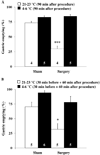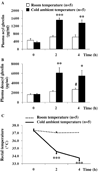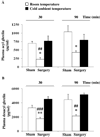Cold ambient temperature reverses abdominal surgery-induced delayed gastric emptying and decreased plasma ghrelin levels in rats
- PMID: 20817059
- PMCID: PMC2967623
- DOI: 10.1016/j.peptides.2010.08.026
Cold ambient temperature reverses abdominal surgery-induced delayed gastric emptying and decreased plasma ghrelin levels in rats
Abstract
We investigated whether acute cold-induced vagal activation through brainstem thyrotropin-releasing hormone (TRH) signaling influences abdominal surgery-induced delayed gastric emptying (GE) in fasted rats. Laparotomy and cecal palpation or sham (short anesthesia alone) was performed 10 min before or 30 min after cold exposure (4-6°C) lasting 90 min. Non-nutrient GE was assessed during 70-90 min of cold exposure. Control groups remained at room temperature (RT). The stable TRH analog, RX-77368 (50 ng/rat) was injected intracisternally immediately before surgery and GE monitored 30-50 min postsurgery in rats maintained at RT. Plasma acyl (AG) and total ghrelin levels were assessed using the new RAPID blood processing method and radioimmunoassays. Desacyl ghrelin (DAG) was derived from total minus AG. In rats maintained at RT, abdominal surgery decreased GE by 60% compared to sham. Cold before or after surgery or RX-77368 normalized the delayed GE. In non-fasted rats, cold exposure increased plasma AG and DAG levels at 2 h (2.4- and 2.7-times, respectively) and 4 h (2.2- and 2.0-times, respectively) compared to values in rats maintained at RT. In fasted rats, abdominal surgery decreased AG and DAG levels by 2.4- and 2.1-times, respectively, at 90 min. Cold for 90 min after surgery normalized AG and DAG levels to those observed in sham-treated animals kept at RT. These data indicate that endogenous (cold exposure) and exogenous (TRH analog) activation of medullary TRH vagal signaling prevent abdominal surgery-induced delayed GE. The restoration of circulating AG levels inhibited by abdominal surgery may contribute to alleviate postoperative gastric ileus.
Published by Elsevier Inc.
Conflict of interest statement
The authors have nothing to disclose. No conflicts of interest exist.
Figures




Similar articles
-
Central administration of pan-somatostatin agonist ODT8-SST prevents abdominal surgery-induced inhibition of circulating ghrelin, food intake and gastric emptying in rats.Neurogastroenterol Motil. 2011 Jul;23(7):e294-308. doi: 10.1111/j.1365-2982.2011.01721.x. Epub 2011 May 13. Neurogastroenterol Motil. 2011. PMID: 21569179 Free PMC article.
-
Abdominal surgery inhibits circulating acyl ghrelin and ghrelin-O-acyltransferase levels in rats: role of the somatostatin receptor subtype 2.Am J Physiol Gastrointest Liver Physiol. 2011 Aug;301(2):G239-48. doi: 10.1152/ajpgi.00018.2011. Epub 2011 Jun 2. Am J Physiol Gastrointest Liver Physiol. 2011. PMID: 21636529 Free PMC article.
-
Abdominal surgery induced gastric ileus and activation of M1-like macrophages in the gastric myenteric plexus: prevention by central vagal activation in rats.Am J Physiol Gastrointest Liver Physiol. 2017 Oct 1;313(4):G320-G329. doi: 10.1152/ajpgi.00121.2017. Epub 2017 Jul 6. Am J Physiol Gastrointest Liver Physiol. 2017. PMID: 28684460 Free PMC article.
-
Intracisternal antisense oligodeoxynucleotides to the thyrotropin-releasing hormone receptor blocked vagal-dependent stimulation of gastric emptying induced by acute cold in rats.Endocrinology. 1998 Sep;139(9):3730-5. doi: 10.1210/endo.139.9.6195. Endocrinology. 1998. PMID: 9724024
-
Importance of medullary thyrotropin-releasing hormone in brain-gut circuits regulating gastric integrity: preclinical studies.J Gastroenterol. 2002 Nov;37 Suppl 14:128-32. doi: 10.1007/BF03326431. J Gastroenterol. 2002. PMID: 12572880 Review.
Cited by
-
Ghrelin - a pleiotropic hormone secreted from endocrine x/a-like cells of the stomach.Front Neurosci. 2012 Feb 16;6:24. doi: 10.3389/fnins.2012.00024. eCollection 2012. Front Neurosci. 2012. PMID: 22355282 Free PMC article.
-
The influence of environmental temperature on appetite-related hormonal responses.J Physiol Anthropol. 2015 May 3;34(1):22. doi: 10.1186/s40101-015-0059-1. J Physiol Anthropol. 2015. PMID: 25935755 Free PMC article.
-
β1-Adrenergic receptor deficiency in ghrelin-expressing cells causes hypoglycemia in susceptible individuals.J Clin Invest. 2016 Sep 1;126(9):3467-78. doi: 10.1172/JCI86270. Epub 2016 Aug 22. J Clin Invest. 2016. PMID: 27548523 Free PMC article.
-
A RAPID Method for Blood Processing to Increase the Yield of Plasma Peptide Levels in Human Blood.J Vis Exp. 2016 Apr 28;(110):53959. doi: 10.3791/53959. J Vis Exp. 2016. PMID: 27166969 Free PMC article.
-
Brainstem neuropeptides and vagal protection of the gastric mucosal against injury: role of prostaglandins, nitric oxide and calcitonin-gene related peptide in capsaicin afferents.Curr Med Chem. 2012;19(1):35-42. doi: 10.2174/092986712803414097. Curr Med Chem. 2012. PMID: 22300074 Free PMC article. Review.
References
-
- Ao Y, Go VL, Toy N, Li T, Wang Y, Song MK, et al. Brainstem thyrotropin-releasing hormone regulates food intake through vagal-dependent cholinergic stimulation of ghrelin secretion. Endocrinology. 2006;147:6004–6010. - PubMed
-
- Arancibia S, Rage F, Astier H, Tapia-Arancibia L. Neuroendocrine and autonomous mechanisms underlying thermoregulation in cold environment. Neuroendocrinology. 1996;64:257–267. - PubMed
-
- Barquist E, Bonaz B, Martinez V, Rivier J, Zinner MJ, Taché Y. Neuronal pathways involved in abdominal surgery-induced gastric ileus in rats. Am J Physiol. 1996;270:R888–R894. - PubMed
-
- Barquist E, Zinner M, Rivier J, Taché Y. Abdominal surgery-induced delayed gastric emptying in rats: role of CRF and sensory neurons. Am J Physiol. 1992;262:G616–G620. - PubMed
-
- Bonaz B, Plourde V, Taché Y. Abdominal surgery induces Fos immunoreactivity in the rat brain. J Comp Neurol. 1994;349:212–222. - PubMed
Publication types
MeSH terms
Substances
Grants and funding
LinkOut - more resources
Full Text Sources
Other Literature Sources
Medical

